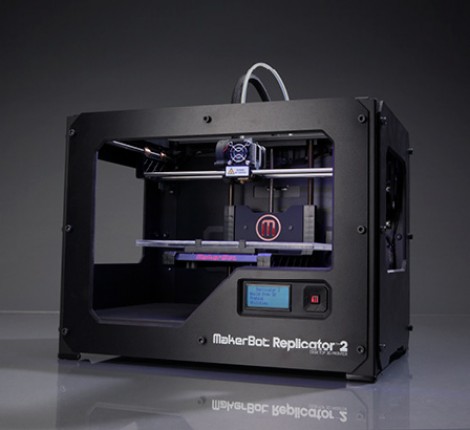
MakerBot’s new Replicator 2. Courtesy of MakerBot.
Latest News
September 20, 2012
It isn’t difficult to find naysayers about 3D printing moving from offices and factories and into homes. Maybe additive manufacturing (AM) will be offered as a service by places like Kinkos or Home Depot, they say. The naysayers talk about the machines being too expensive, or too difficult for people to work with, or about the average consumer not understanding how to create CAD-type images to print out.
I’m not sold on the idea 3D printers are too hard for average folks to work with. Pushing a button to make something print seems pretty intuitive to me. What if something breaks? Well, what if something on a computer breaks? How many people actually know how to fix something inside a computer? That certainly hasn’t stopped sales.
Consumers are better educated about how 3D design works than most experts would lead you to believe. The Sims is essentially a design program, as is Minecraft, Spore and any number of level editors. You can find plenty of free 3D design tools online, and more that can be had for a reasonable price. Even without the ability to design in 3D, objects ready to be printed are only a Google search away.
With all that in mind, we are left with price as a concern. Hobbyist printers can already be had for a price point equivalent to an iPad. True, the overall quality of the least expensive 3D printer isn’t much to write home about, but that is changing, and quickly. Which brings me to MakerBot.
MakerBot has launched its newest 3D printer, the Replicator 2. Even without getting into specs, it already lays to rest one of my criticisms of hobbyist machines (including previous MakerBot products). The company isn’t even marketing it solely to hobbyists. It’s targeting engineers and industrial designers. Instead of coming as a kit like MakerBot’s previous printers, the Replicator 2 comes fully assembled and ready to use, along with a copy of MakerWare, MakerBot’s 3D modeling program.
So how about quality? The Replicator 2 has a layer resolution of 100µ (0.0039 in) and the images I’ve seen of objects created with the new system don’t show signs of obvious layer strata. MakerBot’s new machine also offers a build envelope of 11.2 x 6.0 x 6.1 in. (28.5 x 15.3 x 15.5 cm). Both layer thickness and build envelope are comparable or superior to professional desktop 3D printers. The Replicator 2 has been designed to use poly lactic acid (PLA), making it green as well.
Other 3D printers with similar specs start at $9,000. The Replicator 2 is being launched at $2,199.
Seeing a 3D printer in action will be part of what sells it to the masses. This notion hasn’t escaped MakerBot’s attention. Taking a page from Apple, the company is opening a store dedicated to selling its systems in Manhattan. The store will also act as a low-volume service bureau, just to let people see what can be done with a 3D printer with their own two eyes.
“Before people buy a MakerBot, they think of all the practical applications – all the stuff they can cross off their ‘honey-do’ list, the things they can fix around the house” – broken parts on the bike or the dishwasher, or a new toothbrush holder to fit a tight space,” said Bre Pettis, cofounder and CEO of MakerBot. “But once they have it, their mind flips a switch. They start printing out amazing things, wonderful things.”
Below you’ll find a video about the Replicator 2. Note how Pettis is targeting engineers and industrial designers, not just hobbyists, in his Replicator 2 marketing efforts.
Subscribe to our FREE magazine, FREE email newsletters or both!
Latest News
About the Author
John NewmanJohn Newman is a Digital Engineering contributor who focuses on 3D printing. Contact him via [email protected] and read his posts on Rapid Ready Technology.
Follow DE






